Rating of gas power generators: ten popular models and tips for buyers
Do you regularly suffer from power outages and have decided to influence the current situation by purchasing a gas power generator? Why not - after all, this type of fuel is affordable, environmentally friendly, and when burned it will not emit thick smoke or an unpleasant odor. But the range of offers is quite wide, and you want to choose a high-quality and reliable device, don’t you?
We will help you cope with this task - in our article we will consider the rating of the best generators of various capacities, we will give their technical characteristics and features of use. Let's talk about the operating rules and features of choosing the appropriate option, based on the needs of a specific buyer.
The content of the article:
TOP 10 gas power generators
Models up to 5 kW
Greengear GE-5000
Reliable mobile generator with four-stroke engine
The Greengear GE-5000 gas generator will be an ideal solution for backup power supply to a small country house, cottage or construction site. A convenient frame and maneuverable wheels, as well as folding handles make it easy to move around the site.
This power generator is designed with three outlets with covers to prevent dust and splashes from entering. There is also one 12 V output - this is extremely convenient if, for example, you need to charge a 12 V car battery.
Specifications:
- cooling – air;
- engine/displacement – four-stroke, GG4GN/390 cc;
- fuel consumption – from 398 g/kWh;
- maximum power – 5.5 kW;
- start – electric, manual;
- number of phases – 1 (220 volts);
- wheels - yes;
- overload protection – yes;
- sockets – 3 + 1 for 12 V;
- noise – 72 dB;
- weight – 83 kg.
The Greengear GE-5000 model is equipped with a four-stroke engine, starts smoothly, and operates almost silently. The latter characteristic allows you to use the device in any conditions - it makes no louder noise than a regular vacuum cleaner, so a working gas generator will not cause problems for you or your neighbors.
- Powerful engine
- Low noise level
- Availability of an informative display
- Good build
- High price
- Perceptible weight
Comfort GAZ-4.5kW-ES
Convenient power generator with overheat protection and silencer
The gas generator Comfort GAZ-4.5kW-ES runs on natural and liquefied gas. Suitable for emergency power supply to a home, garage or temporary country house.
Withstands a maximum load of 4.5 W, which must be taken into account when calculating the required power - if your house has a boiler, pumping station, electric stove and washing machine, then they cannot be turned on at the same time so as not to overload the generator.
Specifications:
- cooling – air;
- engine/volume – four-stroke/389 cc;
- fuel consumption – 1.6 l/h;
- maximum power – 4.5 kW;
- start – electric;
- number of phases – 1 (220 volts);
- wheels - yes;
- overload protection – yes;
- sockets – 2;
- noise – 74 dB;
- weight – 83 kg.
The design of this model includes a 1-liter oil sump, which allows for more economical fuel consumption.
The kit may include a set of washers, nuts, bolts, grommets, as well as a clamp, a cable for charging the battery and other accessories. The exact quantity and list of which must be clarified before purchasing - the equipment may change by the manufacturer.
- High quality build
- Economical fuel and oil consumption
- Quiet operation
- Rich set of accessories included
- Wheels for easy movement
- High price
- Only 1 year warranty
Greengear GE-3000
Compact generator with a powerful engine for back-up power supply to the cottage
Greengear GE-3000 is a gas power generator with a nominal power of 2.8 kW. One-time can withstand a maximum load of 3 kW.
It will be the optimal solution for supplying electricity to a small country house. You can also take it on hikes or fishing, but you need to take into account its considerable weight (46 kg), the lack of wheels and handles for moving the structure.
Specifications:
- cooling – air;
- engine/displacement – four-stroke, GG3GN/212 cc;
- fuel consumption – 1.35 l/h;
- maximum power – 3 kW;
- start – electric, manual;
- number of phases – 1 (220 volts);
- wheels - no;
- overload protection – yes;
- sockets – 2 + 1 12 V socket;
- noise – 64;
- weight – 46 kg.
The model is equipped with a muffler, an hour meter and a display that displays maximum useful information. The manufacturer also provides overload protection. A good frame ensures the stability of the structure not only indoors, but also outdoors.
- Informative display
- Excellent build quality
- Very quiet operation
- No handles or wheels
- Impressive weight for its size
- Fairly high cost
Models from 5.4 to 7 kW
Grandvolt GVI 6600 M G
Gas generator with a powerful engine, capable of operating on LPG, main gas and biogas
Grandvolt GVI 6600 M G is an open design generator model. Suitable for backup electricity supply to a private home, small office, modest industrial premises or construction site.
It can operate on almost any gas fuel - mainline, liquefied and even biogas. Capable of regularly generating electricity at extremely low network pressure - 0.8 kPa.
Specifications:
- cooling – air;
- engine/displacement – four-stroke, RAS IC 390 OHV/389 cc;
- fuel consumption – 0.31 kg/kWh for propane and 0.41 m3/kWh for methane;
- maximum power – 6 kW (propane), 5.4 kW (methane);
- launch – manual;
- number of phases – 1 (220 volts);
- wheels - no;
- overload protection – yes;
- sockets – 2;
- noise – 71 dB;
- weight – 70 kg.
Characterized by endurance and stable performance. It is also quite quiet, which allows this generator to be placed close to power consumption points.
Does not require special skills and abilities from the user - for operation and maintenance, just look at the instructions.
- Stable and good-quality frame
- Ability to operate at a line pressure of 0.8 kPa
- Ease of operation and maintenance
- No wheels or carry handle
- Heavy weight
BRIGGS & STRATTON 6 kW
Generator with automatic start and the ability to operate at 30 degrees below zero
The BRIGGS & STRATTON 6 kW model is designed to supply electricity to country houses and even construction sites. Its simple and reliable closed design, as well as a powerful motor, ensures uninterrupted operation in any weather.
The manufacturer provides a muffler, which in combination with a casing significantly reduces the noise level during operation. And the presence of a fine filter allows you to install the generator very close to the house - the minimum permissible distance is 45 cm.
Specifications:
- cooling – air;
- engine/displacement – four-stroke, Briggs & Stratton Intek, OHV/500 cc;
- fuel consumption l/h – 1.06 m3/h (liquefied gas), 3.43 m3 (natural gas);
- maximum power – 6 kW;
- starting – electric + manual starter;
- number of phases – 1 (220 volts);
- wheels - no;
- overload protection – yes;
- sockets – 2 lines (terminals) + grounding;
- noise – 72 dB;
- weight – 114 kg.
The model is equipped with a stainless steel protective casing, which allows it to be used for generating electricity in almost any environment.
This generator can operate at 30 degrees below zero. But to work outside in frosty weather, you will need to additionally purchase a device for working at low temperatures - kit 6262, which includes two oil heaters and one battery heater. You can also purchase additional carbon monoxide and smoke detectors.
- Equipped with a solenoid valve for emergency gas shut-off
- Quiet operation thanks to protective cover
- Good build
- Stable work
- Possibility to install 45 cm from the house
- High price
- Engine oil and filter need to be changed every 100 hours
- No battery included
Greengear GE-7000
Gas generator with powerful four-stroke motor and automatic voltage regulation technology
Greengear GE-7000 is a powerful open-frame emergency power generator. Capable of withstanding a one-time maximum load of up to 7.5 kW. The frame design helps protect the main components of the device from mechanical damage.
The display shows working time, voltage and frequency. It can operate on both liquefied and main gas, using fuel quite economically. The four-stroke engine is reliable and provides smooth operation.
Specifications:
- cooling – air;
- engine/displacement – four-stroke, GG6GN/445 cc;
- fuel consumption – from 318 g/kW*h;
- maximum power – 7.5 kW;
- start – electric, manual;
- number of phases – 1 (220 volts);
- wheels - yes;
- overload protection – yes;
- sockets – 3 + 12 V output;
- noise – 78 dB;
- weight – 89 kg.
The Greengear GE-7000 gas generator will be an excellent solution for a country house, cottage or office, solving the problem of power supply in the event of a power failure. It can cope with the load while simultaneously connecting a boiler, pumping station, microwave, electric kettle and laptop.
- Stable power supply to power your home
- Informative display
- Simple control panel
- Well-built case
- Folding handles on the body and large wheels for easy movement
- High price
- Considerable dimensions and weight
Russian Engineering Group GG6-230SV
Outdoor generator in a noise-, vibration- and moisture-proof container
Russian Engineering Group GG6-230SV is a real mini-power plant for backup power supply. It will be an excellent solution for private houses, country cottages and summer cottages, the energy consumption of which is 6 kW. It is also suitable for construction sites and other objects.
This generator is equipped with a reliable innovative casing, which allows it to be installed outdoors - rain, snow, wind and sun rays are not a problem for the equipment. Also, the design of the mini-container and the presence of a muffler ensures a very low noise level during operation, so the device can be installed near a residential building.
Specifications:
- cooling – air;
- engine/displacement – four-stroke, REG432/432 cc;
- fuel consumption – 0.30 kg/kWh. (propane); 0.40 m3/kWh. (methane);
- maximum power – 6 kW;
- starting – electric starter/automatic;
- number of phases – 1 (220 volts);
- wheels - no;
- overload protection – yes;
- sockets - terminals;
- noise – 66 dB;
- weight – 130 kg.
The engine life of this generator is about 6000 hours due to the forced lubrication system. The manufacturer's warranty on the device is 1 year or 300 operating hours. After which the generator requires full maintenance, including changing the oil and worn parts.
- Starting even at a temperature of -34 degrees and low pressure in the line
- Moisture-proof and noise-proof mini-container (casing)
- Low noise level
- Works on main and liquefied gas
- You can supplement the generator with an automation unit
- Considerable weight and impressive dimensions
- No wheels
Models with power from 8 kW
Generac 7144
Powerful station with a remote control system in a vandal-proof casing
The Generac 7144 generator can be used as a backup power source for a cottage, office with office equipment in the event of a long-term absence of power supply. Its continuous operating mode is about 200 hours. But this device is not intended for use in critical life support systems. Also, you cannot connect a welding machine to it.
The robust body of the protective casing is all-weather capable of withstanding precipitation and wind gusts of up to 240 km/h. The special design of the housing and the presence of a muffler ensure that during operation the generating station produces minimal noise - about 60 dB.
The device is equipped with a remote control and monitoring system.
Specifications:
- cooling – air;
- engine/displacement – Generac G-Force/530 cc;
- fuel consumption – 6.16 l/h on liquefied and 3.62 m3/h on natural;
- maximum power – 8 kW;
- start – electric, automatic;
- number of phases – 1 (220 volts);
- wheels - no;
- overload protection – yes;
- sockets – terminals, power cable connection;
- noise – 62 dB;
- weight – 155 kg.
The Generac 7144 gas generator operates from both main gas and bottled gas. Its installation is only possible outdoors. The base of the generator station housing is a lattice pad made of composite material, which is installed directly on the ground and holds the equipment in its original position, preventing subsidence or sinking.
If the equipment is to be used in difficult weather conditions and at temperatures of -18 degrees and below, then you will need to purchase a heating kit.
- Standard Wi-FI remote control system
- Ease of maintenance
- Low noise level
- Anti-vandal casing
- Warranty 5 years or 2000 operating hours
- High price
- Connection and commissioning work must be carried out by a specialist
BRIGGS & STRATTON 14 kW
Generator in a noise-proof casing with electronic speed control
Mini-power station BRIGGS & STRATTON 14 kW is equipment intended for home use. It is designed to serve loads from heating, air conditioning, and autonomous water supply systems as a temporary power source. It will be an ideal solution to the issue of emergency power supply to a country house.
The BRIGGS & STRATTON 14 kW model can operate on main gas and liquefied gas - the main thing is to correctly reconfigure the system when changing the type of fuel.
Specifications:
- cooling – air;
- engine/displacement – Briggs and Stratton Vanguard V-Twin/993 cc;
- fuel consumption – 5.3 kg/h for bottled and 6.6 m3/h for main;
- maximum power – 14 kW (propane), 2.6 kW (methane);
- start – electric;
- number of phases – 1 (220 volts);
- wheels - no;
- overload protection – yes;
- sockets - terminals;
- noise – 67 dB;
- weight – 227 kg.
The installation and connection of this gas generator, in accordance with the manufacturer's recommendations, should only be carried out by a qualified and certified electrician.
Installation is possible purely outdoors, but thanks to the noise-proof housing, the equipment can be placed at a distance of 45 cm from the house, but provided that the removal of combustion products is properly organized. Thus, exhaust should not enter open windows, doors, air intakes, or garage doors. The manufacturer also recommends installing a carbon monoxide detector indoors.
- Good build quality and stainless steel body
- Possibility of installation 45 cm from the house
- Solenoid valve for emergency gas shut-off
- Fine air filter
- 3 year warranty
- It is necessary to change the engine oil and filter every 100 operating hours
- Large dimensions and weight of the station
- A kit for operation at low temperatures must be purchased
Russian Engineering Group GG14-230V
Reliable electric generator that uses main gas efficiently and economically
The Russian Engineering Group GG14-230V mini-power station can operate on both natural and liquefied gas. But, thanks to the innovative developments of the manufacturer, it is the natural one that is most effective and economical.
The equipment is suitable for domestic use - as a temporary power source for a private home, cottage, construction site, office.
Specifications:
- cooling – air;
- engine/volume – REG 803/803 cc;
- fuel consumption – 0.30 kg/kWh. (propane) / 0.40 m3/kWh. (methane);
- maximum power – 14 kW;
- start – electric;
- number of phases – 1 (220 volts);
- wheels - no;
- overload protection – yes;
- sockets - terminals;
- noise – 68 dB;
- weight – 150 kg.
The Russian Engineering Group GG14-230V generator is capable of withstanding a short-term load of 20% higher than the declared power. And this feature allows the consumer to power electric motors, powerful pumps and other equipment with high starting currents (short-term).
- Increased service life up to 6000 hours
- Starts at low temperatures
- Capable of operating at low pressure (0.8 kPa)
- The muffler ensures fairly quiet operation
- Autostart kit needs to be purchased
- Heavy weight and no wheels
- There is no protective case (container)
Criteria for choosing the optimal generator
To select the optimal generator that will become a reliable source of autonomous power supply, it is necessary to clearly determine purpose of its use. This can be either a backup power supply for a small country house or an emergency power supply for an office space. In the latter case, you will have to take a closer look at gas generators for continuous operation.
The distinctive features of the equipment used to supply power to various facilities are clearly presented in the following photo selection.
Depending on the purpose of use, the main characteristics that the electric generator must have will differ.
The main parameters influencing the choice of electricity generator are:
- power;
- installation location;
- fuel type;
- launch type;
- additional functions;
- manufacturer's reliability.
Next, we will consider these criteria and their features in more detail.
Criterion #1 - power selection
When purchasing a household gas-powered generator to generate electricity, it is important to choose the right power. It should be enough to serve the main consumers.
Therefore, when calculating, you should sum up the power of electrical appliances, which first of all need to be provided with backup power supply in the event of a centralized power outage. For example, a pumping station, a refrigerator, a boiler, light bulbs. And such consumers as a washing machine, dishwasher, TV or computer, iron are secondary - i.e. You can do without them for some time.
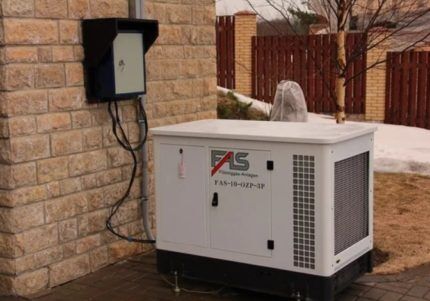
The power parameter of a specific electrical appliance for calculations should be taken from its passport. And don't forget about the starting current - some equipment requires several times more electricity to start than to operate.
Below we suggest that you familiarize yourself with the table of power and starting current of the main household electrical appliances.
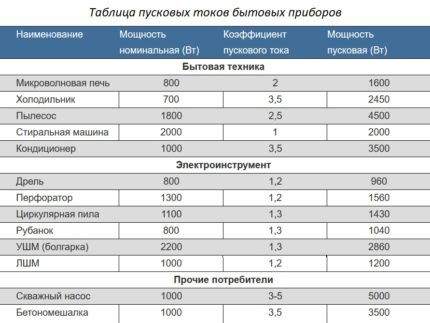
Having added up the power of all the devices that you will use during a power outage, you need to add 15-20% of the reserve - the generator should not work at the limit of its capabilities. The resulting number will be the optimal power of your electric generator.
As the experience of numerous buyers shows, for backup power supply to a small home, equipment with a capacity of 5 kW is most often purchased. There is enough power here to service a gas boiler, well, or boiler.
Criterion #2 - installation location
The installation location is also one of the important criteria when choosing equipment. Initially, you should decide on the location of the future installation - on the street or V indoors.
Outdoor models, as a rule, are equipped with a protective casing that can withstand exposure to sunlight, gusts of wind, and prevents precipitation.
Some models without a container can also, according to the manufacturer’s recommendations, be installed outdoors. But they need to be protected from rain, snow, wind and other atmospheric phenomena.
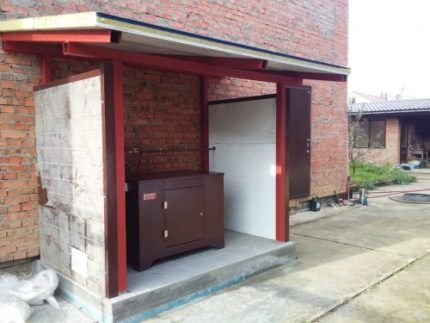
Criterion #3 - fuel type
Equipment for autonomous power supply varies according to the type of fuel used to generate electricity.
Generators are:
- gasoline;
- diesel;
- gas;
- hybrid.
Hybrids can use gasoline or gas to operate (liquefied or mainline). To change the type of fuel, you need to follow the manufacturer's instructions.
We will look at the features of electric generators using different types of fuel in detail in the next gallery.
Criterion #4 - launch type
Another criterion for choosing an electric generator is the type of start-up.
Generators start up:
- manual;
- electric start;
- remote;
- auto.
Many models have two types of start – most often manual and electric start.
The most convenient option is automation, which allows you to practically eliminate the presence of a person - the system will automatically start and turn off when the centralized power supply is turned off and on. But such equipment is more expensive.
Next, we will consider the features of each type of launch in the following photo selection.
Criterion #5 - additional features
In addition to the main functions, additional functions are also important for comfortable operation of the equipment. One of these is heating oil filter and generator. This is an important option if you plan to use the generator in the cold season at sub-zero temperatures. But a number of manufacturers offer a heating kit for an additional fee.
Also important for many users number of sockets, Availability power And 12V output. The latter is of interest to buyers for charging car batteries and other electricity consumers.
A 32A power outlet is needed if you plan to connect powerful electrical equipment. And not all models have it.
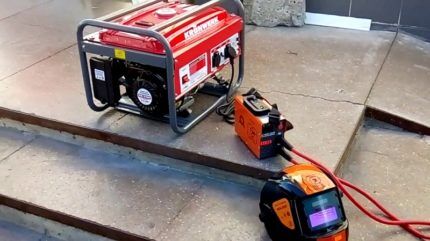
For ease of use, the presence of protective casing – models with a container can be placed both outdoors and indoors.
Another point to pay attention to when choosing is winding generator It could be copper or aluminum. Copper is more expensive and has a longer service life.
Criterion #6 - manufacturer reliability
Products from a well-known brand are more expensive – this rule is also true for generators. But the manufacturer’s reputation guarantees that the equipment will meet the stated characteristics and will work as expected (and even more).
But it’s better not to buy cheap Chinese generators of an unknown brand - they will not fulfill their warranty period. And it often happens that instead of the copper winding indicated in the passport, they have a copper-painted winding, and the actual power is almost half less than the declared one.
Reliable manufacturers of gas generators include brands such as GENERAC (American company Generac Power Systems), BRIGGS & STRATTON (American company of the same name), Russian Engineering Group (RusInzhGroup company), Comfort GAZ (Russian company GARANT LLC), Grandvolt (Hydrokinetics LLC, representative of ESPA GROUP (Spain)).
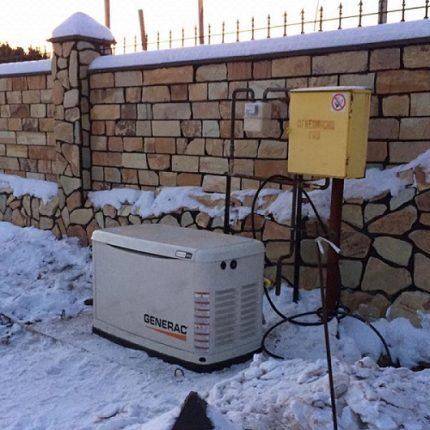
You should also check before purchasing availability of a service center specific manufacturer in your city, town or region. This is needed in case the generator breaks down.
Recommendations for using a gas generator
The gas generator can be installed both indoors and outdoors. If the first option is chosen, then the same standards apply as for installing a boiler, water heater, stove and any other gas-using equipment - you must select a room with an area of at least 15 m3, correctly connect the equipment and install gas leak sensor.
Regardless of what gas will be used (liquefied or main gas), before operation it is important to pay attention to ensure that there is an influx of fresh air and removal of exhaust gases. Generator manufacturers also warn about this. That is, it is important to ensure effective forced ventilation, as well as for gas boiler.
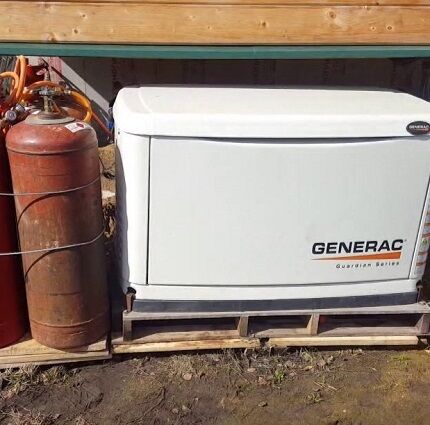
If you plan to connect the device to the main gas, then you will need to coordinate your actions with the gas supplier and obtain special permission, as for connecting any gas-using equipment.
For this purpose, you will need to provide a certificate of purchase of a gas generator, its registration certificate and a certificate of conformity. In case of a positive decision, install on the gas pipeline gas tap for fuel supply. And only a gas service employee with special permission has the right to do this. Be prepared that you will have to pay for the work to connect the gas generator.
You can also immediately conclude maintenance contract gas equipment. After all, a number of models require maintenance every 100 operating hours.
Conclusions and useful video on the topic
Features of choosing and connecting a gas generator:
Recommendations for choosing a generator:
Recommendations for choosing an autonomous power plant by fuel type:
What type of starting of an electric generator is preferable:
Having understood the main selection criteria and determined the total power of electrical appliances that will require backup power in the event of a power outage, you can begin to select the optimal option. And our rating of the most popular generators among buyers will help you decide.
How often does your electricity go out and do you have a generator? If yes, then share your experience of using it - in the feedback block you can leave comments and add a photo of your generator, as well as ask your questions to our experts and other site visitors.



